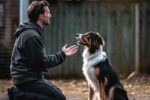Unleashing Solutions: Dealing with Common Dog Behavior Issues

Addressing dog behavior problems is crucial for ensuring a happy and well-balanced companion. Dealing with common dog behavior issues such as barking, chewing, and separation anxiety can be challenging, but with the right strategies, you can find effective solutions. Research has shown that consistent training, socialization, and proper exercise are key factors in addressing these behavior problems. Understanding the underlying causes and implementing positive reinforcement techniques can also play a significant role in modifying unwanted behaviors.
Understanding Barking Behavior in Dogs
Barking is a natural form of communication for dogs, but excessive barking can become a behavior problem. It’s important to understand the reason behind your dog’s barking to effectively address the issue. Dogs may bark due to boredom, fear, frustration, or as a response to stimuli in their environment. Providing mental and physical stimulation, teaching alternative behaviors, and using positive reinforcement training can help reduce excessive barking. Seeking professional guidance and addressing any underlying medical conditions are also recommended in managing barking behavior.
When addressing excessive barking, it’s essential to provide your dog with mental and physical stimulation to prevent boredom. Enrich their environment with interactive toys and puzzles that engage their mind and keep them occupied. Additionally, regular exercise through daily walks or play sessions can help release excess energy and reduce the likelihood of excessive barking.
Excessive barking in dogs can stem from a variety of underlying issues. By understanding the reason behind your dog’s barking behavior and implementing appropriate strategies, you can effectively address and manage this common behavior problem.
Positive reinforcement training is another valuable tool in managing barking behavior. By rewarding your dog for quiet and calm behavior, you can encourage them to bark less. Teach them alternative behaviors, such as “quiet” or “speak,” that provide an acceptable outlet for their vocalization. Consistency and patience are key in this training process.
Barking Behavior Modification Tips:
- Identify the underlying cause of your dog’s barking.
- Provide mental and physical stimulation to prevent boredom.
- Teach alternative behaviors through positive reinforcement training.
- Seek professional guidance for severe or persistent barking issues.
- Address any underlying medical conditions that may contribute to excessive barking.
| Barking Trigger | Management Strategies |
|---|---|
| Boredom | Provide interactive toys and engage in regular exercise. |
| Fear | Create a safe environment and gradually desensitize your dog to fear-inducing stimuli. |
| Frustration | Teach alternative behaviors and provide outlets for frustration. |
| Response to stimuli | Redirect your dog’s attention and reward calm behavior. |
Managing Chewing Behavior in Dogs
Chewing is a common behavior in dogs, especially during their teething phase. However, destructive chewing can be a problem if it involves valuable items or causes harm. To manage chewing behavior, it’s essential to provide appropriate chew toys and engage in regular play and exercise to release excess energy. Puppy-proofing your home and using deterrent sprays can also help redirect your dog’s chewing behavior. Consistent training, positive reinforcement, and avoiding punishment are key in modifying chewing behavior and promoting appropriate chewing habits.
Providing Appropriate Chew Toys
One effective strategy for managing chewing behavior is to provide your dog with appropriate chew toys. This helps redirect their chewing instinct onto items that are safe and suitable for them. Choose chew toys that are designed specifically for dogs, such as rubber or nylon toys that are durable and can withstand strong chewing. Avoid giving your dog items that resemble things they are not supposed to chew, such as old shoes or household items. By offering a variety of chew toys and rotating them regularly, you can keep your dog engaged and satisfied.
“Providing appropriate chew toys is crucial to redirecting your dog’s chewing behavior and saving your belongings from destruction.”
Engaging in Regular Play and Exercise
Dogs often resort to destructive chewing when they are bored or have excess energy. By engaging in regular play and exercise sessions with your dog, you can help them burn off energy and reduce their urge to chew on inappropriate items. Take your dog for daily walks, provide interactive toys that encourage physical activity, and engage in playtime that stimulates their mind and body. This not only helps prevent destructive chewing but also promotes overall health and well-being.
Puppy-Proofing Your Home
Puppy-proofing your home is another essential step in managing chewing behavior. Remove any items that you don’t want your dog to chew on, such as shoes, electrical cords, or fragile objects. Keep valuable items out of your dog’s reach and create designated areas or rooms where they can safely explore and play. Use baby gates or other physical barriers to restrict access to certain areas until your dog learns appropriate chewing habits.
| Chew Toy Recommendations | Material | Durability |
|---|---|---|
| Rubber Kong Classic Dog Toy | Rubber | Very durable |
| Nylabone Dura Chew | Nylon | Durable |
| West Paw Design Zogoflex Hurley Dog Bone | Rubber | Durable |
In summary, managing chewing behavior in dogs requires providing appropriate chew toys, engaging in regular play and exercise, and puppy-proofing your home. Consistent training, positive reinforcement, and avoiding punishment are crucial for modifying chewing behavior and promoting appropriate chewing habits. By implementing these strategies, you can ensure your dog’s chewing behavior is both safe and manageable, allowing for a harmonious coexistence with your furry companion.
Alleviating Separation Anxiety in Dogs
Separation anxiety is a common issue that many dogs face, causing distress and undesirable behaviors when left alone. To help alleviate separation anxiety in dogs, it is important to employ gradual desensitization and counterconditioning techniques.
One effective method involves gradually increasing the duration of absences, starting with short periods and gradually extending them over time. This helps your dog become more comfortable being alone and reduces their anxiety. Providing interactive toys and engaging in mentally stimulating activities can also help redirect their focus and alleviate anxiety during periods of separation.
Creating a positive association with being alone is crucial. This can be achieved by establishing a consistent leaving and returning routine, allowing your dog to understand that you will always come back. Additionally, seeking guidance from a professional dog behaviorist or trainer can provide valuable insights and techniques tailored to your dog’s specific needs.
In severe cases, behavioral medications prescribed by a veterinarian may be necessary to help manage separation anxiety. However, medication should always be used in conjunction with behavior modification techniques and under the guidance of a professional.
FAQ
What are some common dog behavior issues that need to be addressed?
Common dog behavior issues that should be addressed include barking, chewing, and separation anxiety.
How can I effectively address excessive barking in my dog?
To address excessive barking, it’s important to determine the underlying reason behind the behavior. Providing mental and physical stimulation, teaching alternative behaviors, and using positive reinforcement training can help reduce excessive barking. Seeking professional guidance and addressing any underlying medical conditions are also recommended.
How can I manage destructive chewing behavior in my dog?
To manage destructive chewing behavior, provide appropriate chew toys and engage in regular play and exercise to release excess energy. Puppy-proofing your home and using deterrent sprays can also help redirect your dog’s chewing behavior. Consistent training, positive reinforcement, and avoiding punishment are key in modifying chewing behavior and promoting appropriate chewing habits.
How can I alleviate separation anxiety in my dog?
To alleviate separation anxiety, gradually desensitize your dog to being alone using counterconditioning techniques. This involves gradually increasing the duration of absences, providing interactive toys, and creating a positive association with being alone. Implementing a consistent leaving and returning routine, seeking professional guidance, and considering behavioral medications in severe cases can also help address separation anxiety in dogs.






